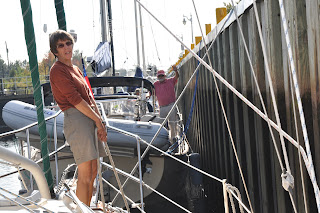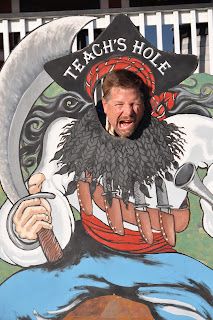The ICW south of Charleston, SC , all the way to north Florida, especially Georgia, had some interesting challenges mostly due to higher tidal ranges (10 feet) and greater currents due to the larger volume of flowing water. Also, being closer to the Atlantic Ocean with many inlets, full moon tides, and howling north winds for two weeks straight meant that we had to be on our toes all the time. Georgia has very limited resources to keep up with the constant shoaling (our most commonly used word for a week) which often occurs at the ocean inlets creating underwater banks that cut right across dredged waterway channels. The lack of dredging in Georgia provides a great livelihood for companies like Seatow and Towboat US who, for a fee, will pull unlucky and unprepared mariners alike back into the ICW.
We spent many nights anchored in small creeks just off the waterway in what is called the " low country", sheltered from the open Atlantic by a chain of barrier islands. There were very few trees and at night, with the north wind howling through the rigging and Windspell dancing at her anchor due to strong tidal currents, this made for some restless nights with poor sleep. Are you beginning to get the picture? Perhaps the drizzling 50 degree dampness and having no more than 12 inches of water under our keel with less lucky boats aground for us to use as channel markers as we inched by them, helps to paint the picture.
Windspell became a "channel marker" once ( it was our turn) at Dafuskie Island, Ramshorn Creek, mile 570 of the ICW. A local power boater pulled us off on a rising tide. We would have had to wait six hours if we had gone aground on a falling tide. The good Samaritan told us that the buoy marking the shoal we hit was washed away two weeks earlier by hurricane Sandy.
But all that is passed us now. The water is clear and turquoise. Windspell has dried out with the warm sunny weather and we saw our first manatee yesterday. The beaches of Fort Lauderdale are wonderful.
Earlier, Dafuskie Island was mentioned. It got its name because it is " The first Key" encountered along the Eastern seaboard.
The ICW ( we now refer to it as the icyW) has new challenges in Florida, called bridges. We went under at least ten of them yesterday, each of which you have to contact by radio to request an opening. They are like synchronized traffic lights. Heaven help you if you get out of sync. If you do it is a least a 15 to 30 minute wait until the next opening and if there is a 20 knot wind and a 3 knot current pushing you toward the bridge span and you are in line with several other boats that missed the opening it can be dicey, but diplomacy and sound seamanship has prevailed so far.....
We will be in Miami in the next few days which marks the southernmost point before we sail across the Gulf Stream to the Bimini islands of the Bahamas. But first we will visit our kids in Ottawa and restock Windspell.
 |
| High tide in St. Augustine..evidence of global warming |
 |
| Spanish soldier circa 1700, Castello de San Marcos |
.JPG) |
| Dental extraction tool in a Spanish colonial surgeon's kit, works like a pipe wrench! |
 |
| Down jacket weather |
 |
| The top 1% of America's rich |
 |
| Fort Lauderdale fish sculpture made of disguarded pop bottles |
 |
| The beaches of Fort Lauderdale |
.JPG) |
| A small cottage on the ICW |











.JPG)
.JPG)
.JPG)
.JPG)
.JPG)


.JPG)




.JPG)









.JPG)
.JPG)
.JPG)
.JPG)
.JPG)
.JPG)
.JPG)
.JPG)
.JPG)
.JPG)






.JPG)



.JPG)

.JPG)
.JPG)





.JPG)
.JPG)